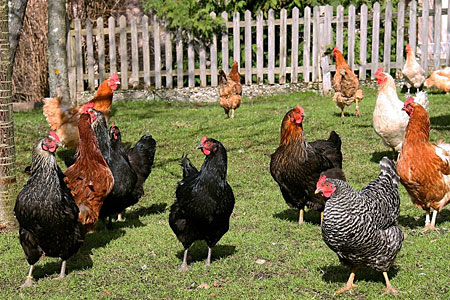
For exhibition purposes, large chicken breeds recognized by the American Poultry Association (APA) are organized into six classes. Most of the classes represent the geographic region where the breeds originated or were developed. Knowing a chicken’s APA class lets you infer a number of things about the breed, including temperament, laying ability, climate tolerance, and more.
American Class
The 13 breeds in the American class originate within the United States or Canada. Chickens in this class are heavy to mid weight, and the hens are good layers of eggs with brown shells. Their hefty weight plus good laying ability make these chickens dual-purpose egg-and-meat breeds.
As a group they tolerate cold weather better than warm weather. Their cold hardiness results in part from the fact that they put on fat more easily than breeds in most other classes.
In general these breeds tend to be relatively calm in temperament. And they are all good foragers.
Popular breeds in the American class include Buckeye, Chantecler, Delaware, Dominique, Jersey Giant, New Hampshire, Plymouth Rock, Rhode Island Red, Rhode Island White, and Wyandotte.
Asiatic Class
The 3 breeds in the Asiatic class originate primarily from China. They are feather-legged. They tend to be large, meaty birds. And they prefer cool climates over warmer areas.
Like the American breeds, the Asiatic breeds are typically docile. They, too, lay eggs with brown shells, although in general they don’t lay quite as well as the American breeds. The most common members of the Asiatic class are Brahma and Cochin.
Continental Class
The 11 breeds in this class originate from European countries other than those comprising Great Britain. This class is further subdivided into three regional groups.
Breeds in the Northern European subgroup hail from Belgium, Germany, and the Netherlands. They are mid to lightweight breeds, good layers of eggs with brown or tinted shells, and exceptional foragers. Some are flightier than others, and some are less tolerant of warm weather. This group includes Lakenvelder, Barnevelder, Hamburg, and Welsumer.
The Polish subgroup includes one breed: Polish. Oddly enough, the Polish chicken is not from Poland, but from the Netherlands. This crested breed comes in numerous color varieties, as well as bearded and non-bearded. Polish chickens are good layers of eggs with white shells. They are a docile breed that does best in a temperate climate.
Popular breeds in the French subgroup include Crevecoeur, Faverolle, Houdan, and Marans. Hailing from France, they are all heavy breeds. Otherwise they are a mixed bag as to laying ability, egg shell color, temperament, and climate tolerance. This is one case where a chicken’s APA class doesn’t tell you much about the breed.
English Class
The 6 breeds in the English class originate from Great Britain and Australia. They are heavy breeds that tend to be more cold hardy than heat tolerant. Most English breeds are essentially dual-purpose chickens, being good layers of eggs with brown or tinted shells. Among the most popular English breeds are Australorp, Orpington, and Sussex — all docile.
The stand-out in this group is the Cornish breed, which can sometimes be aggressive. The hens are rather poor layers, although both genders make excellent meat birds. The Cornish breed is the basis for Cornish-cross meat hybrids.
Mediterranean Class
The 7 breeds in the Mediterranean class originate from Italy and Spain. They lay eggs with white or lightly tinted shells and range in laying ability from excellent to poor. They also range in size from lightweight to heavy.
As a group the Mediterranean breeds are more heat tolerant than cold hardy. They tend to be quite high strung and less likely to brood than most other breeds.
On the other hand, they are excellent foragers which, combined with their outstanding ability to evade predators, makes them particularly suitable for free ranging. Popular Mediterranean breeds include Leghorn, Sicilian Buttercup, and Spanish.
All Other Standard Breeds
A final catch-all class is All Other Standard Breeds (AOSB), which includes those that don’t handily fit into any of the other five classes. These 13 breeds are further divided into three subgroups.
The first subgroup is Games, consisting of non-Oriental game fowl from Great Britain. Greatest in popularity is the Old English breed. Originally developed for cockfighting, this lightweight breed can be flighty and sometimes aggressive. The hens are rather poor layers, but are outstanding broodies. The Old English breed is active, hardy, and an exceptional forager with remarkable survivability skills.
The second subgroup is Orientals, even though the breeds in this group don’t all come from eastern Asia. Popular among them are the Aseel from India, Cubalaya from Cuba, Phoenix developed in Germany, Sumatra from Indonesia, and Yokohama from Japan. These breeds are not especially good layers, but tend to make good or excellent broodies. Because of their varying origins, they range widely in egg shell color, temperament, size, and climate hardiness, making them difficult to characterize as a group.
The third subgroup is Miscellaneous, consisting of these disparate breeds: Ameraucana from the United States, Araucana from Chile, Naked Neck from Romania, and Sultan from Turkey. Laying ability varies, and shell color ranges from blue to white to brown. Broodiness ranges from fair to unlikely. Size, temperament, and foraging ability also vary. However, all breeds in this group are gentle and docile.
A Chicken’s APA Class
A chicken’s APA class can provide hints about some of the characteristics you can expect of the breed. However, it’s important to note that not all breeds, and not all strains or individuals within a breed, will fit the breed’s essential class profile. Still, by knowing the chicken’s APA class as listed in the American Standard of Perfection, you can often infer a number of things about the breed that may help you choose the most appropriate chickens for your backyard flock.
And that’s today’s news from the Cackle Coop.
Gail Damerow has written a number of poultry-keeping books, including The Chicken Encyclopedia.

